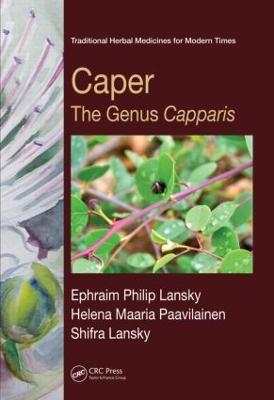
Caper
Crc Press Inc (Verlag)
978-1-4398-6136-3 (ISBN)
This book tracks the use of the genus Capparis from the present position of caper fruit and its flowers as a niche culinary article of economic importance, to ancient times and its use in traditional medicine of the Mediterranean and the Middle East. Section I covers the various classes of compounds found in Capparis that hold potential for being physiologically and medically active, including alkaloids, flavonoids, vitamins, and proteins and amino acids. Section II examines therapeutic uses for Capparis species for medical conditions such as inflammation, rheumatism, diabetes mellitus, pain and fever, cancer, infections and infestations, hypertension, and more.
The authors balance the role of this plant in mythological and religious thinking with advances in modern chemical and pharmacological research. Coverage of ethnomedical usage leads to practical discussions of how the unique evolution of the genus Capparis impacts present and future applications of the different species for medicine and therapeutic nutrition. Providing chemical and pharmacological reviews to an extent not previously undertaken, this book will serve as a firm basis for scientists interested in conducting research on this novel source of safe phytoceutical agents.
Ephraim Philip Lansky, MD (University of Pennsylvania), PhD (Leiden University), MBA (University of Bradford), BA (New College, Sarasota, Florida), is the author or coauthor of 28 peer-reviewed publications, five patents, and two books (Pomegranate: The Most Medicinal Fruit, Basic Books, New York; and Figs: the Genus Ficus, CRC Press, Boca Raton, FL). He is also the founder of Rimonest Limited and Punisyn Pharmaceuticals Limited, companies devoted to the economic development of the pomegranate fruit for nutraceutical, cosmeceutical, and medical applications, respectively. He has 30 years of clinical experience in acupuncture, herbology, homeopathy, and hypnosis. He directs the Laboratory of Applied Metabolomics and Pharmacognosy (LAMP) within the Institute of Evolution, University of Haifa, Israel, and maintains an international consulting practice in complementary medicine and pharmacognosy. Shifra Lansky holds a BSc in chemistry from Hebrew University in Jerusalem, Israel, where she is presently pursuing her graduate studies. Her focus is on characterizing the three-dimensional structures of naturally occurring proteins. Shifra enjoys playing the violin, painting, and skiing in her spare time. Helena Paavilainen is a researcher at the Hadassah Medical School, Hebrew University of Jerusalem, Israel. Her main research interests are ethnomedicine, historical ethnopharmacology, and the history of pharmacology, especially the Hebrew, Arabic, and Latin traditions. She wrote her PhD thesis (published as "Medieval Pharmacotherapy: Continuity and Change; Case Studies from Ibn Sina and Some of His Late Medieval Commentators," Leiden: Brill 2009) on the development of medical drug therapy in medieval times and on the potential validity of medieval herbal treatments. She also coauthored with Dr. Lansky the monograph Figs: The Genus Ficus (Boca Raton, FL: CRC Press, 2010). She currently works as a freelance consultant bioprospecting ancient and medieval herbal texts for practical applications in medicine, functional nutrition, and agriculture.
Mythopoesis/Meditation. Botany and Introduction. Section I: Chemistry. Alkaloids. Fatty Acids. Flavonoids. Glucosinolates and Isothiocyanates. Minerals. Proteins and Amino Acids. Sterols. Terpenoids and Other Volatile Compounds Excepting Isothiocyanates. Vitamins. Other Compounds. Section II: Medical Uses. Oxidative Tension. Inflammation. Rheumatism. Lipid Dyscrasias. Diabetes Mellitus. Sunburn. Pain and Fever. Xerostomia. Cancer. Infections and Infestations. Lepsis. Hypertension. Section III: Miscellany. Reviews. Propagation. Fermentation. Recipes. Breaking Advances in Medical Capparology. Centers of Capparology. Epilogue. Index.
| Reihe/Serie | Traditional Herbal Medicines for Modern Times |
|---|---|
| Zusatzinfo | 78 Tables, black and white; 10 Illustrations, color; 464 Illustrations, black and white |
| Verlagsort | Bosa Roca |
| Sprache | englisch |
| Maße | 178 x 254 mm |
| Gewicht | 793 g |
| Themenwelt | Medizin / Pharmazie ► Medizinische Fachgebiete ► Pharmakologie / Pharmakotherapie |
| Medizin / Pharmazie ► Naturheilkunde | |
| Naturwissenschaften ► Biologie ► Botanik | |
| Naturwissenschaften ► Chemie | |
| Technik | |
| Weitere Fachgebiete ► Land- / Forstwirtschaft / Fischerei | |
| ISBN-10 | 1-4398-6136-6 / 1439861366 |
| ISBN-13 | 978-1-4398-6136-3 / 9781439861363 |
| Zustand | Neuware |
| Haben Sie eine Frage zum Produkt? |
aus dem Bereich


